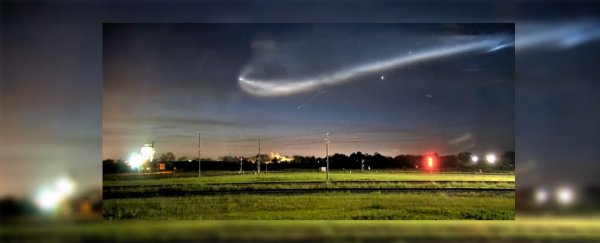In the wee morning hours of Thursday (May 5), a camera in Waycross, Georgia, witnessed a mysterious object streaking through the sky.
Bright, fast, and trailed by a glowing oblong aura, the object looked a bit like a space jellyfish, as Chris Combs, a professor of aerodynamics and mechanical engineering at the University of Texas at San Antonio put it on Twitter.
Of course, as Combs pointed out, this space jelly was no UFO – it was a SpaceX Falcon 9 rocket launching from Florida's Kennedy Space Center, roughly 250 miles (400 kilometers) south of the camera.
Dozens of rockets leave the launchpad at Kennedy every year, but few of them could rightly be mistaken for a bioluminescent invertebrate in the sky. So, what happened here?
According to Combs, it's a combination of physics and perfect timing.
SPACE JELLYFISH
— Chris Combs (iterative design enjoyer) (@DrChrisCombs) May 6, 2022
From today’s SpaceX launch. Beautiful pic.twitter.com/98mzIGHDOm
For starters, the long, blobby "body" of the jellyfish is simply exhaust leaving the Falcon 9's rocket engine nozzle, Combs wrote.
The reason the exhaust takes on such a bulbous shape has to do with the pressure difference inside and outside the nozzle.
In this case, the exhaust leaving the nozzle is "under-expanded" – meaning the gas is at higher pressure than the ambient air around it as the exhaust leaves the engine's nozzle.
To match the ambient background pressure in the atmosphere, the rocket exhaust drops its own pressure by expanding as soon as it leaves the nozzle, according to Combs.
"In under-expanded exhaust you get expansion fans at the nozzle exit to decrease pressure and match background: jellyfish, at high altitude," Combs tweeted.
That explains the blob. But what about the glow?
This is much simpler to square, Combs said – and it just comes down to timing.
Because the rocket launch occurred in the pre-dawn hours of Thursday morning (around 5:45 am local time (09:45 am UTC)), light from the sun came from just over the horizon, illuminating up the exhaust plume, causing it to glow brightly against the dark sky.
Physics plus perfect timing equals space jellyfish. A simple equation for a high-altitude spectacle.
Of course, if you'd like to see a real space jellyfish, you'll need to look just a bit further into space – about 300 million light-years further to be exact.
That's how far away the galaxy cluster Abell 2877 is; when astronomers recently looked at the object with a radio telescope, they saw the ghostly outline of a jellyfish swimming through distant space.
That big jelly in the sky is also the result of a large gas explosion – in this case, a massive eruption from a gaggle of ancient black holes, Live Science previously reported.
Related content:
Crash! 10 biggest impact craters on Earth
Voyager to Mars Rover: NASA's 10 greatest innovations
Interstellar space travel: 7 futuristic spacecraft to explore the cosmos
This article was originally published by Live Science. Read the original article here.
